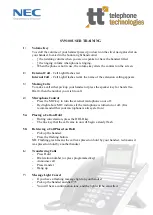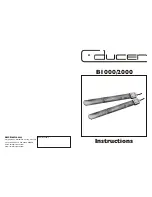
S E C T I O N O N E
ANTENNA TYPES
The size of an antenna is directly related to the
wavelength of the frequency to be received. The most
common types used in wireless audio systems are 1/4-
wave and 1/2-wave omni-directional antennas, and
unidirectional antennas.
Omnidirectional Antennas
The size of a 1/4-wave antenna is approximately
one-quarter of the wavelength of the desired frequency,
and the 1/2-wave is one-half the wavelength. Wavelength
for radio signals can be calculated by dividing the speed of
light by frequency (see “The Wave Equation”). For example,
a 200 MHz wave has a wavelength of approximately 6 feet
(2 m). Therefore, a 1/2-wave receiver antenna would be
about 3 feet (1 m) long, and a 1/4-wave antenna would be
about 18 inches (45 cm). Note that antenna length
typically needs to only be approximate, not exact. For VHF
applications, an antenna anywhere from 14-18 inches
(35-45 cm) is perfectly appropriate as a 1/4-wave
antenna. Since the UHF band covers a much larger range
of frequencies than VHF, 1/4-wave antennas can range
anywhere from 3 to 6 inches (7-15 cm) in length, so using
the proper length antenna is somewhat more important.
For a system operating at 500 MHz, a 1/4-wave antenna
should be about 6 inches (15 cm). Using an antenna
tuned for an 800 MHz system (about 3 inches, 7 cm,
in length) in the same situation would result in less than
optimum pickup. Wideband omnidirectional antennas
that cover almost the entire UHF band are also available
for applications where receivers with different tuning
ranges need to share a common antenna (see “Antenna
Distribution” page 9).
1/4-wave antennas should only
be used when they can be mounted
directly to the wireless receiver
or antenna distribution system;
this also includes front-mounted
antennas on the rack ears. These
antennas require a ground plane
for proper reception, which is
a reflecting metal surface of
approximately the same size as the
antenna in at least one dimension.
The base of the antenna must be
electrically grounded to the receiver.
The chassis of the receiver (or
distribution system) provides the
necessary ground plane. Do not use
a 1/4-wave antenna for remote antenna mounting.
A 1/2-wave antenna does not require a ground plane,
making it suitable for remote mounting in any location.
While there is a theoretical gain of about 3 dB over a
1/4-wave antenna, in practice, this benefit is seldom
realized. Therefore, there is no compelling reason to
“upgrade” to a 1/2-wave antenna unless remote antennas
are required for the application.
Unidirectional Antennas
A second type of antenna suitable for remote
mounting is a unidirectional, such as yagi or log periodic
antennas. Both types consist of a horizontal boom and
multiple transverse elements. They can provide up to 10
dB more gain than a 1/4-wave antenna, and can also reject
interfering sources from other directions by as much as 30
dB. Yagi antennas are rarely used in wireless microphone
applications due to their quite narrow bandwidth, usually
just a single TV channel (6 MHz). The log periodic antenna
achieves greater bandwidth by using multiple dipoles
whose size and spacing vary in a logarithmic progression.
A longer boom and more elements result in greater
bandwidth and directivity. Some unidirectional antennas
have built-in amplifiers to compensate for losses due to
long cable runs.
ANTENNA SETUP
Wireless Systems Guide for
5
The Wave Equation
1/4 wave and 1/2 wave antennas: UHF range
Wideband
omnidirectional
antenna
Summary of Contents for ANTENNA SETUP
Page 2: ......





































